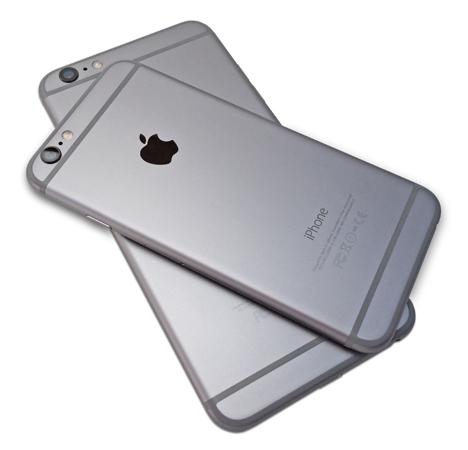iPhone 7 May Sport Dual Lenses for DSLR Quality
A new rumor suggests that the next iPhone could boast dual camera lenses for snapping DSLR-like photos.

Apple's iPhone has long been a worthy replacement for point-and-shoot cameras, and the handset could be gunning for your DSLR next. According to a new rumor, the follow-up to the iPhone 6 and 6 Plus could sport dual camera lenses to allow for photos that could rival those of a premium DSLR camera.
As reported by Apple Insider, this rumor sprang out of the latest episode of The Talk Show podcast, during which host John Gruber claimed that "a birdie of a birdie" tipped him off about the future iPhone's purported dual-lens construction. Gruber didn't have much to offer in terms of technical specifications, but noted that his source claimed that "next year's camera might be the biggest camera jump ever."
MORE: 100+ Best Gadget Gift Ideas 2014
Next year would be a smart time for Apple to make a big leap in the camera space, as all iPhones have utilized some variation of Apple's 8-MP iSight camera since 2011's iPhone 4s. Subtle hardware and software improvements have enhanced the iSight's image quality over the years, including the True Tone flash that debuted with the iPhone 5s and the optical image stabilization that's exclusive to this year's iPhone 6 Plus.
If Apple is indeed planning to bolster its iPhone camera offerings for next year, it has all of the necessary patents to do so. The company patented a three-lens, three-sensor mobile imaging device last year, and has also secured the right for a mechanism that would let you swap out camera lenses at-will.
We generally found Apple's iPhone 6 and 6 Plus to be two of the sharpest smartphone shooters on the market, and, while it's crazy to start thinking about an iPhone 6s or 7, we're eager to see if the handset's camera does make as drastic a jump as it's rumored to.
Mike Andronico is an Associate Editor at Tom's Guide. Follow Mike @MikeAndronico. Follow us@TomsGuide, on Facebook and on Google+
Get instant access to breaking news, the hottest reviews, great deals and helpful tips.
Mike Andronico is Senior Writer at CNNUnderscored. He was formerly Managing Editor at Tom's Guide, where he wrote extensively on gaming, as well as running the show on the news front. When not at work, you can usually catch him playing Street Fighter, devouring Twitch streams and trying to convince people that Hawkeye is the best Avenger.
-
gggplaya Wow, the author shows his ignorance of photography in this article.Reply
First the iphone never rivaled point and shoot cameras, maybe the sub$100 cameras, but not a normal point and shoot.
Second, in no way does adding more lenses equate to the picture quality, depth of field, and light capturing abilities of a full size lense. Or the nice and large pixels of a full size image sensor. Photographers don't go out and buy $5k worth of lenses for no aparent reason.
Thrid, more megapixels != better pictures. There are much more aspects to a good photo than pixel density. Like color, saturation, lighting, focus etc..... -
may1 Reply14620779 said:
Second, in no way does adding more lenses equate to the picture quality, depth of field, and light capturing abilities of a full size lense. Or the nice and large pixels of a full size image sensor. Photographers don't go out and buy $5k worth of lenses for no aparent reason.
Well, you never know what Apple might come up with.
If they managed to utilize independent lens and sensors to create a single image, for example using 2 1/3 inch sensors (basically two of the ones used in current gen iphones), it should be technically better than a point and shoot with small aperture (which usually sports a 2/3 inch sensor) because it uses 2 lenses for more light exposure.
Then again, that's provided Apple already has the technological capabilities to merge 2 independently captured images into one with high fidelity - which would obviously result in compromising some aspects of the images taken from both lenses. So yeah, what you're saying about the next iphone being unable to achieve DSLR images, let alone point and shoot - is probably right
-
StormyIV Should I buy the Iphone 7? Or just wait another month for the iPhone 8 to come out? Decisions, decisions, decisions lol. On a more serious note, what a surprise Apple is already talking about their Iphone 7 even though the 6 came out last month..Reply -
RedJaron Yeah, as ggg says, until a phone camera sports a larger image sensor, they can't rival a decent $250 P&S pocket camera for image and color quality. And until they use a bigger lens, their aperture control will be non-existent and the light capturing limited. And the obsession with thin phones precludes them from offering a proper optical zoom lens, which is vastly superior to digital software zoom.Reply
Soooo, they can't get a properly sharp, crisp, saturated image ( making enlargements rather pointless, ) they can't properly control depth of field, they'll suffer in poor lighting, and they can't zoom in without greatly blurring the image quality. Yep, this could surely replace my Canon 40D . . . -
glasssplinter Sounds like the author is right up there with the rest of them. Just because you have an icrap and instagram does not make you a serious photographer. Until phones get huge sensors and lenses they will not equal DSLR quality. Which at that point you might as well just buy a real camera but that's not as hip as the newest itard device. I doubt that you'll ever see a full size lens mount as well which prevents so many advantages of a real camera.Reply
Crapple supporters will believe anything, look at the "photo contest" they had a while back where you could only use your icrap. The winning images were all strikingly similar to Nat Geo photos and all hailed as original works of art... -
rh_dog When it comes to photography of any sort, "you know nothing" Michael Andronico, as other people have said, until an iPhone sports a APS-C or full frame sensor (not currently possible in the current phone form factor), they will not rival DSLRs. Oh Puhleeeze. Let's see an iPhone take even a measly 6 fps at 5 megapixels in low light inside a high school gym and have the images come out anything other than completely unfocused dark mess.Reply -
dstarr3 There's a reason DSLRs have larger sensors and larger lenses. Because sensors and lenses need to be large for quality photographs. It's that simple.Reply -
Solandri ReplyWell, you never know what Apple might come up with.
Ugh. Smartphone picture quality is limited by physics and geometry. Not even Apple has magic which can counter those.
If they managed to utilize independent lens and sensors to create a single image, for example using 2 1/3 inch sensors (basically two of the ones used in current gen iphones), it should be technically better than a point and shoot with small aperture (which usually sports a 2/3 inch sensor) because it uses 2 lenses for more light exposure.
DLSR photos are higher quality because the sensor is a lot bigger. That means each photocell is bigger. That means when you open the shutter to snap the picture, each pixel gets hit by more light, which means a more accurate and less noisy image.
DSLR lenses are big because when you make the sensor bigger, you have to increase the focal length of the lens in order to capture the same field of view. The field of view captured by a 28mm lens on a full-frame DSLR sensor is the same as 3.9mm lens on a 1/3" sensor.
You can't put a longer focal length lens on a phone camera because it's so thin to begin with. The focal length is the distance from the center of the lens to the sensor plane. This is simple geometry. The three ways to get a longer focal length into a shorter distance between lens and sensor.
- Using a parafocal design. But those just shift the problem from after the lens to before it. The lens ends up being bigger in front than a normal lens design.
- Folding the light path with mirrors. This has been used on some point and shoot cameras. A 45 degree mirror or prism under the lens redirects the light, so the sensor sits at 90 degrees to the lens. Unfortunately, the sensor size then ends up being the limiting factor - a 1/3" sensor is 3.6mm in its shortest dimension. So there's no way to get a much bigger sensor into the current crop of 6-8mm phones.
- Using a light field camera (i.e. no lens). Unfortunately these are still in the early stages and probably won't be competitive with optical lens designs for another 10-20 years.
Putting two lenses and two sensors can in theory help, but combining the images from two lenses introduces parallax errors. If the lenses are mounted 4mm apart (pretty much the minimum for a 1/3" sensor), and your photos are, say, 12MP, that means in any picture with field of view less than 16 meters, there's a 1 pixel or greater offset between what the images the two sensors record. You can't combine them with a simple add and combine operation - that would actually make the pictures blurrier (this is in fact exactly what causes depth of field blur in regular photos - the large surface area of the lens means all the light from an object by the lens doesn't focus onto the same pixels).
3CCD video cameras get around this problem by splitting the light from the same lens onto 3 sensors. But that defeats the whole reason for doing this - getting more light onto the sensors. You'd just be splitting the light which used to fall on one sensor to fall upon two.
P&S and phone camera picture quality has been improving because of one thing - sensor technology has constantly improved and each year so a same-size photocell can produce a cleaner image using less light. The physics and geometry of the light and lenses has remained unchanged since the earliest photos in the 1800s. As gggplaya said, anyone who thinks you can get around these limits by playing with lenses is ignorant of photography. -
mesab66 A simple quick glance at any DSLR and everyone can see instantly the years of technology evolution that must have taken place.Reply
To suggest that the isheep shepard has managed to throw the optical physics rulebook out of the window and reduced the entire functionality to such a small size that it can be incorporated as a tiny subcomponent of a mobile phone - and achieve "DSLR quality" is utter bullsh#t.
-->yes, of course, technology will advance and Apple might be laughing all the way to the bank, but they are making a fool of themselves with headlines like this, and anyone that supports this view will be held in the same light. DSLR's are built the way they are for many correct reasons.
Unfortunately, isheep will keep craping out money to help fuel iHeadlines like this.
Time, methinks, for Tom's to commission a proper grown-up comparison...just make sure to apply the same reasoning to build/desire a high end PC, then showing the differences in photography results from an phone camera to high end pro DSLR.
-
Amencerment So does that mean that I need to throw away my over $5K in Nikon gear and get the Iphone 7...Reply
I think I need to follow the rest of the heard, lead the way Ole' Shepard Mr. Cook...
I just had the best dream, that someone writing an article about apple products was right.
It's kinda funny that when people start the apple roomers and the flocks will follow.
It is a said thing when someone really thinks that a phone will match even a DSLR from 15 years ago, and the audacity of a "premium DSLR".
For me all I know is the day a phone matches my camera setup, I will call it quits and become a hermit in Alaska. Maybe pan for gold until Apple finds away for the Iphone to create gold better.
Until then, I still like my Note 3 better then my Wives' Iphone 6... Yeah she's a poser too....

